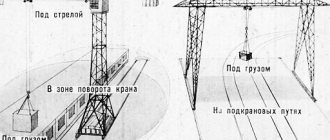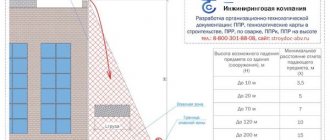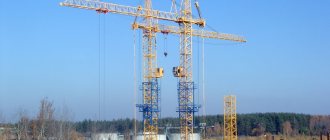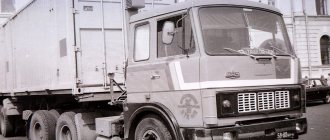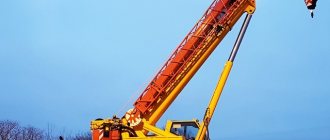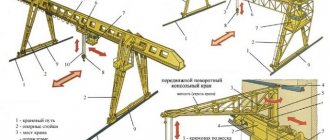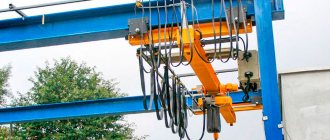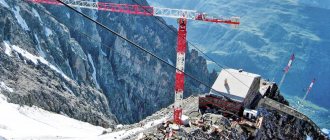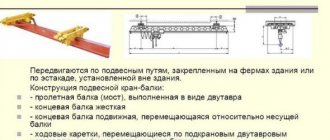Main components of overhead cranes
The design of an overhead crane is relatively simple. The design includes several main components and auxiliary crane equipment. The main elements that make up an overhead crane are the bridge (span) and end beams. The bridge is bolted to the end beams. The overhead crane moves along the crane tracks along the loading platform.
Superstructure (bridge)
It consists of one or two beams, which, depending on the technical requirements and operating conditions of the crane, are made of a round, box-shaped section or from an I-beam reinforced with pipes.
Bridge cranes with a bridge consisting of one girder (single girder) are lighter and are usually used in enclosed spaces for loads up to 20 tons.
Double Girder Cranes
heavier and designed to handle loads weighing up to 100 tons. The span length can reach 60 meters.
End beams
They are a support for the span. Due to the installed running wheels, the overhead crane moves along the crane track. Based on the type of fastening, support and suspended end beams are divided.
In the support type, the wheels of the end beams in the upper part rest on the crane tracks. In suspended ones, the fastening is made to the lower flange of the I-beam.
End beams are made of box section or from channels using welding. The material used is high-strength alloy steel. The structure can be strengthened with special stiffening ribs.
Support overhead crane
Overhead overhead crane
What is load capacity?
Liebherr LTM 1350 truck crane lifting characteristics
The crane's lifting capacity is the main parameter determined by the maximum weight of the load that the equipment can lift while maintaining strength and stability. For boom-type equipment, the lifting capacity refers to the mass that it can lift at a minimum reach - the more it increases, the less mass the boom can withstand.
This parameter is largely determined by the load moment. It is calculated as the product of the radius in meters and the weight of the load. The unit of measurement is tonometers. The length of the boom reach is determined from the vertical axis drawn through the center of gravity of the load to the axis of rotation drawn through the portal or support trolley.
Equipment for overhead cranes
Depending on the assigned tasks and operating conditions, overhead cranes are equipped with devices that operate from manual or electric traction. Hand-pulled control is typically provided by a drive chain through the physical efforts of the crane operator. Such cranes are used for infrequent movements of loads weighing up to 10 tons.
Electric overhead cranes are equipped with modern electric drives, which facilitate the operation of heavy overhead cranes and ensure the movement of heavy loads weighing up to 50 tons or more. Next, we will look at the basic mechanisms of overhead cranes that ensure their movement, safety, gripping and lifting of loads.
Motors (geared motors)
, installed on the end beams of electric overhead cranes, are part of the mechanism for moving the crane along the crane tracks. Torque is transmitted from the engine through the gearbox to the running wheels of the end beams, and accordingly, movement is carried out along the rails.
Crane trolleys
installed on double-girder overhead cranes to allow installation and movement along the span of the lifting device. Made in the form of a welded frame with running wheels. They are also equipped with gear motors for movement along the span. Some overhead crane designs are equipped with two load trolleys for moving large and heavy loads.
Brakes
are an important element of electric overhead cranes when moving large loads. The accuracy of crane positioning during work depends on the quality and condition of the brake system. In most cases, a shoe or disc-shoe braking system is used for overhead cranes. All gear motors installed on the crane are equipped with brakes.
Cabins
installed on overhead cranes to ensure control of the process of moving goods. For low lifting heights (up to 22 m), a stationary cabin is usually installed at one end of the crane bridge. At higher heights, it is recommended to install a mobile cabin to provide better visibility during work. Depending on the location of operation of the overhead crane (outdoors or indoors), closed or open type cabins are provided.
Lifting mechanisms
are installed on overhead cranes to ensure lifting, lowering and moving loads along the span. Due to their reliability and efficiency, the most popular in use are manual hoists and electric hoists. These devices are characterized by the fact that to increase the strength and speed of lifting loads, as well as holding the load at a height, they use a special system - a chain hoist. The system consists of several blocks (movable and fixed) connected by a rope or chain. Thus, hoists are classified into chain and rope. And depending on the mobility along the bridge - stationary and mobile.
To equip overhead cranes with increased lifting capacity, electric winches of an expanded configuration are often used.
Load-handling devices are installed on cranes depending on the characteristics of the cargo (chemical composition, physical state, dimensions, etc.) These include hooks, grabs, electromagnets and staples.
- Grabs are necessary for capturing loose, fibrous materials, shavings and long lumber.
- Hooks are used for hanging loads. They are equipped with safety elements that prevent the load from falling out.
- Staples are used when reloading rolled metal products. They come in different sizes and have minimal weight.
- Electromagnets are used for remote gripping of cast iron and steel loads.
- In situations that require greater precision in operation, for example, in overhead crane structures for the metallurgical industry and when stacking cargo, a rigid suspension is used.
On a note
In the production and assembly of overhead cranes, we use high-quality materials and reliable components. As lifting devices we offer installation of electric hoists made in Bulgaria
or
Russian
production. The reliability, durability, and maintainability of these devices have been tested by time. Our specialists will help you choose the most optimal modification of the hoist in terms of price-quality ratio.
Types of lifting cranes
Classification is carried out according to the load-handling mechanism, the possibility of movement, the type of chassis and drive. According to their design, lifting cranes are divided into the following types:
- boom - an organ for grabbing materials is attached to a trolley or boom;
- pavements - the same principle of connection with movement along the bridge;
- cable - moving a cargo trolley with a load-handling device along a supporting rope on supports.
The first type is the most extensive: tower, automobile and pneumatic tires, tracked, console, wall-mounted, manipulators. The second type includes gantry and bridge lifting devices.
Types of lifting cranes
Another classification of lifting cranes allows us to divide equipment into the following groups:
- for load-handling equipment: hook, piledriver, hardening, pin, grab, container;
- according to the ability to move: stationary, adjustable, mobile, self-propelled, trailed;
- by type of chassis: tracked, wheeled, automobile, rail, special chassis, etc.;
- by drive: electrical, mechanical, manual, hydraulic, etc.
Other classifications of lifting equipment are also permitted.
Additional equipment: safety and efficiency of overhead cranes
Equipping an overhead crane with additional electronic and mechanical devices significantly increases the operating efficiency of the equipment, the safety of work, improves controllability, and also helps prevent rapid wear of components and mechanisms.
- Crane scales are necessary to determine the exact weight of cargo during loading and unloading operations. Attached to the load-handling mechanism.
- Load limiters - prevent equipment from being overloaded. Installed on the rope of the lifting mechanism. Lifting of loads is switched off if their permissible weight is exceeded.
- Radio control and floor control are alternative options for operating the crane from the cab. Installation of radio control (control from the floor) ensures safe work, greater visibility for the operator, and more accurate positioning of the load. Transferring an overhead crane from control from the cabin to control from the floor provides a number of financial advantages, such as savings on personnel, savings on mandatory certification of crane operators, and savings on industrial safety expertise.
- Frequency converters are connected to motors to ensure smoother running of overhead crane units, avoid jerking and excessive swinging of loads, and prevent overloads in the operation of electric motors. This increases engine life and reduces equipment repair and maintenance costs.
How are tower cranes different from each other?
High-altitude special equipment comes in different types and differs in a number of design solutions.
According to the principle of mobility:
- Stationary cranes do not have a running gear. They are often made attached. Such crane structures are firmly attached to the building they are constructing. Attachable crane equipment cannot be moved around the construction site. But in comparison with a mobile one, it is cheaper, has a higher load capacity and is easier to install.
- Mobile cranes – can move around the construction site. They differ according to the type of undercarriage. The most common option is rail. The rails are reliable and make it possible to control the movement of the tower giant from the operator’s cabin. At the same time, the rails must be inspected and checked for defects from time to time. The stability of the crane directly depends on how the rails are laid and what condition they are in.
In addition, mobile crane equipment can be located on a tracked or truck-mounted platform, or have a pneumatic-wheeled undercarriage. There are also tower-type walking special equipment.
By type of tower - with a rotating tower and with a fixed one. The entire crane with a slewing tower rotates, with the exception of the frame and trolley. If the tower is stationary, then only the boom part rotates.
According to the type of boom structure, there are lifting and beam booms. The lifting boom has a lifting and loading device located at the end. The boom part can rise at an angle to the tower, or fall down. The beam boom is motionless. A cargo trolley is installed on it, which moves along the entire length of the boom part, changing the position of the lifting mechanism.
In addition, tower crane structures are available in quick installation, topless and high-rise types. The first ones are designed in such a way that they can be assembled on the construction site as quickly as possible.
In topless structures, the boom element is held in a horizontal position not by cables, but by other mechanical devices. Finally, high-altitude lifting equipment is designed for the construction of skyscrapers.
Video: crane - what it's made of.
Features of the design of mixers with a thermostat
Modern technologies make using the mixer simpler and more convenient. Devices equipped with a thermostat are gradually gaining popularity. What distinguishes them from a conventional faucet is the presence of a thermocouple that controls the flow of hot and cold water to bring the flow to a predetermined temperature. A handle is mounted outside, with which the temperature indicators are set. Another lever regulates the water pressure coming from the spout.
Water faucets with a temperature sensor are very convenient to use. Using the valve, only the pressure of the water flow is regulated, and the temperature value can be set in advance
Read more about this type of faucets in the article: Faucet with a thermostat: design and principle of operation + example of self-installation.
Main settings
The lifting capacity of a crane is not the only characteristic by which equipment is selected. Attention is also paid to the following characteristics:
- boom radius - the distance from the axis of rotation of the rotating part to the vertical axis of the load-handling device;
- lifting height – vertical distance from the gripping equipment to the floor;
- lowering depth - the distance from the parking level from the gripping device in its initial working position;
- lifting/lowering speed – rate of movement of the load vertically.
Load-height characteristics of the DEK-401 crane
These and other parameters must be indicated in the technical data sheet along with the operating conditions. Used to draw up production instructions for the slinger and crane operator.
Truck crane load characteristics
The cargo technical characteristics of the truck crane include the parameters of the vehicle chassis:
- Number and power of engines;
- Operating weight of the crane;
- Number of chassis axles.
Interesting: The largest truck crane in the world, Zoomlion, capable of lifting loads up to 2000 tons, is installed on a 12-axle chassis with four engines.
Most often, domestic crane installations of the KS type and others are mounted on MAZ, KamAZ, Ural, ZIL, KrAZ truck chassis.
Previously, we wrote about what brands of truck cranes exist.
